Course:FNH200/2014w Team18 CheeseCake
Introduction
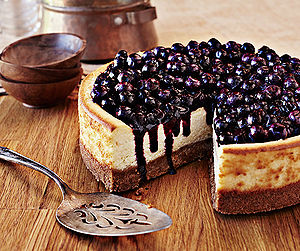
Cheesecake is a type of pastry that is eaten all over the world and has many flavours and complexities. It is a unique dessert which can be presented in multiple aspects and usually contains a subtle sweet and savoury taste where each ingredient serves a different purpose in creating the perfect final product. Each element not only creates flavour but also affects texture and shelf life or preservation. In this assignment we will examine the history of the mighty cheesecake as well as the individual ingredients in the classical New York style cheesecake.
Types of Cheesecakes
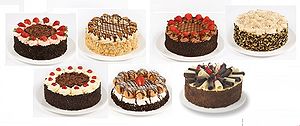
Cheesecakes, like apples, come in many different shapes, sizes, and tastes and vary depending on which country they originate from. These delicacies contain one or more layers, where the main custard layer contains soft, fresh cheese, eggs, and sugar, or a similar derivative. In some cases, there is a bottom layer, analogous to a crust, which is made from crushed cookies, or graham crackers [3]. Some examples of cheesecakes which have crusts are certain ones from South African, Bulgarian, and Dutch/Belgian style cheesecakes while others made in Poland, Sweden, and France usually do not have a crust [3]. Though not required, this delightful treat can also be topped with some fruits, whipped cream, nuts, jam, or syrup to complement the taste. Additionally, some cheesecakes are baked (usually if they have a crust) while some do not require this step and are usually refrigerated [3].
What is New York Style Cheesecake
New York style cheesecake is one of the most historical and simple cheesecakes absent of any fancy ingredients or modifications. It is a classic cheesecake made with pure cream cheese, cream, eggs and sugar with a biscuit crust as the base. In the 1900s, cheesecakes were very popular in New York and each restaurant had there own individual twist in their creations. New Yorkers believed that their city had the best cheesecake bakers and connoisseurs and that cheesecake was not really cheesecake unless it was made in New York [4]. They eventually referred to their cheesecakes as "New York cheesecakes" and thus the name was created.
History
It is believed that cheesecakes first originated in Greece in the island of Samos circa 2000 BC[5]. Cheese molds were discovered by anthropologists and were thought to be used in the making of the earliest cheesecakes[5]. Other cheese products have likely been around for thousands of years before this, however we will never truly know because this was prehistoric (before written history).
In Greece, cheesecake was served to athletes of the first Olympic games in 776 BC because it was thought to be a good source of energy and nutrition[5].
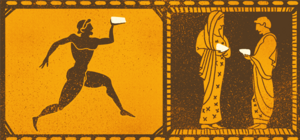
Additionally, it was a common wedding cake in Greece, the simple ingredients of wheat, honey, flour, and cheese were appealing and delicious to the people of this time[7]. Today, we have many more complicated recipes made available to us compared to these simple wedding “cheesecakes”[5]. Athenaeus, wrote the very first cheesecake recipe in 230 AD. Even though cheesecake was served for thousands of years in Greece before this, this is the oldest surviving recipe we have discovered to date [7]. The recipe was simple- mix cheese until smooth, add honey and flour, pour into a brass pan and allow it to sit and cool, then enjoy!
After the romans conquered Greece, the cheesecake recipe was altered and started including eggs and crushed cheese. It was used in pastries and on special occasions, they called It “libuma”[8]. Marcus Cato is accredited with the earliest Roman cheesecake recipe around the first century BC[5]. When the Roman Empire began to expand, the cheesecake reached the Europeans. Each country in Europe put their own spin on the cheesecake recipe, combining a mixture of different ingredients native to each country. The first cookbook was printed in 1545, describing the cheesecake as a “flour-based sweet food”[5].
The cheesecake did not start to resemble what we know today, however, until the 18th century, when the Europeans replaced yeast with beaten eggs[5]. Finally the Americans are the ones who added the signature ingredient of cream cheese after a dairy farmer from new york accidentally discovered cream cheese while trying to make the French cheese Neufchatel. Shortly after cream cheese was packaged and distributed by the Philadelphia cream cheese brand which eventually was bought by Kraft, who coined their own cheesecake recipe that we are now all very fond today!
Chemical Reactions
Cooking processes change the texture and taste of food.There are different types of chemical reactions which occur during cooking resulting in the formation of new substances through irreversible processes dependent on the energy available. For example, when baking a cheesecake, the colors of the crust and surface of the cheesecake will turn brown. Moreover, the heat energy also solidifies the batter to form a cake. These are chemical reactions that are called caramelization, protein denaturation and coagulation, respectively.
Protein Denaturation
Protein denaturation is a process in which protein loses its secondary or tertiary structure by applying abnormal conditions: the presence of alcohol, acid, base, inorganic salt, freezing and heat[9]. The shapes and structures of proteins, which correlate to the functions of the proteins are altered irreversibly (rarely reversibly), due to the disruption and destruction of the bonds among the protein molecule under external stress and treatments[10]. Denaturation reactions are not strong enough to alter the peptide bonds between the amino acids of the proteins, thereafter, the sequence of the amino acids remain the same. However, a denaturation process would cause the loss of biological activity of the proteins, causing the proteins to lose its functions[10].
Denaturation in Cheesecake In the case of making cheesecake, air is being added to the eggs during the step when we beat egg whites into a stiff form. The proteins of the eggs then undergo denaturation as the hydrophilic part of the proteins stay in contacts with the air. These proteins are partially denatured strands surrounding the air bubbles until it is heated in the later procedures, which then fully denatures them [11]. When the eggs are heated, the increase in temperature causes the proteins to unfold and expand their surface area as they continue to denature. The newly exposed parts of the proteins allow new intermolecular bonds to form between the proteins and causes them to clump[11]. In this process, the proteins of the egg are fully denatured and this type of denaturation reaction is irreversible. Denaturing proteins is the most important process in cooking as many delicious foods would never be possible without this process. Some people are concerned about the damage to the proteins during denaturing, however, although the protein structure is changed, the nutritional content still remains and the amino acids are still present for a healthy diet[12].
Coagulation
Coagulation refers to the small particles in a solution forming large particles by grouping together[13]. The process involves denatured proteins altered by forming bonds between one another.
Coagulation in Cheesecake
Coagulation in cheesecake can be summarized by the following three parts[14]:
- The denaturing of egg proteins
- The sugar wraps around the proteins
- Denatured egg proteins coagulate when heated
The coagulation of proteins when heated is influenced by electrolytes, sugar, temperature, time and the reaction of the solution[15]. For example, sometimes, the cheesecake may crack during heating, leaving behind a dry and curdled texture which usually results from overheating the cheesecake.
Non-Enzymatic Browning
Non-enzymatic browning is different from its enzymatic counterpart for it produces a brown color in foods without the activity of enzymes [14]. There are two major types of non-enzymatic browning: caramelization and maillard reaction. The prior usually occurs in cheesecake.
Caramelization Caramelization is widely used in cooking and baking to produce a nutty flavor as well as brown color. When sugar is heated at a suitable temperature, caramelization occurs to produce a characteristic caramel flavor [15]. Generally the reaction is composed of removing water (by evaporation) and breaking down sugar. It is worth noticing that different kind of sugar may caramelize at various temperature. For instance, sucrose and glucose caramelize around 160C (320F) while fructose caramelizes at 110C (230F)[15].
In New York Cheesecake In the case of making New York cheesecake, caramelization is present in the baking of crust. First, sucrose-sugar melts into a liquid form which gradually begins to foam(boils) due to the heat. Afterwards, it breaks down into glucose and fructose and water is loss while the two monosaccharides react with each other [16]. Subsequently, certain aromas will be present, attributing to more complex flavors. To be specific, the products can be classified to the following three: a dehydration product, caramelan C12H18O9, and two polymers,carmelen C36H50O25 and caramelin C125H188O8 [17]. Finally, the crust becomes brown and sticky.
Sensory Properties
External Characteristics
Cheesecakes come in a variety of size and shapes, however, New York style cheesecakes are usually presented in the shape of a circle.
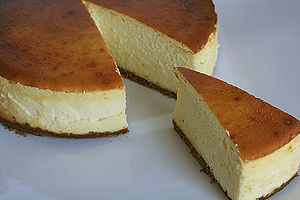
Upon completion, good cheesecakes have a symmetrical, flat, and slightly rounded or sunken top[19]. Its sides should be erect and straight and firm enough to maintain its own integral shape[20]. The surface should also be lightly brown due to caramelization, but the tone may not be necessarily even if mixed poorly[20]. In addition, the surface should also be smooth and glossy, while the crust is thin and golden and the overall product should be attractive, neat and colourful.
Internal Characteristics
New York cheesecakes, unlike its siblings, contain a dense texture and are not as fluffy or airy[19]. Although it is considered a ‘cake’, cheesecakes are not spongy and elastic like their other counterparts but is firm upon touch and malleable when enough force is applied. The interior is of a lighter colour as the cheesecake is only heated long enough for the exterior to heat up but the inside does not attain the same environmental temperature, thus, no caramelization can occur[20]. Subsequently, the interior should also appear grainy or in clumps due to the viscosity of the cheesecake.
Standard Recipe: 9-inch New York Classic Cheesecake
Ingredients [21] and Their Functions
Crust
| Ingredient | Function |
|---|---|
| 1 cup of graham cracker crumbs |
|
| 2 tablespoons of sugar | |
| ¼ cup of unsalted butter melted, plus extra for greasing the pan |
Cheesecake
| Ingredient | Function |
|---|---|
| 4 250g packages of cream cheese at room temperature | |
| 1¼ cups and 2 tablespoons of sugar | |
| 3 tablespoons of cornstarch | |
| 2 teaspoons of vanilla extract |
|
| 2 teaspoons of finely grated lemon zest |
|
| 3 large whole eggs | |
| 1 large egg yolk | |
| 1½ cups of sour cream | |
| 2 teaspoons of lemon juice |
|
Directions[21]
Crust
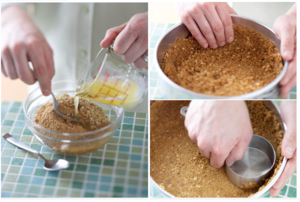
- Preheat the oven to 350ºF.
- For the crust, stir the graham crumbs, sugar and melted butter until evenly combined and press this into the bottom of an ungreased 9-inch springform pan.
- Bake this for 10 minutes, then cool. Brush the sides of the pan with a little melted butter.
Cheesecake
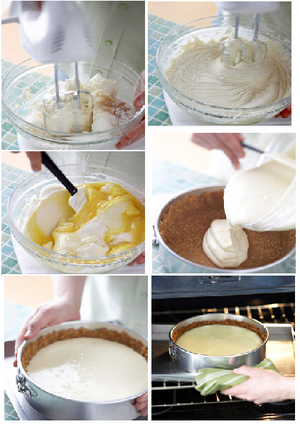
- For the cheesecake, increase the oven temperature to 400ºF.
- Beat the cream cheese until light and fluffy. Add the 1 ¼ cups of sugar a little at a time, and scraping the sides and bottom of the bowl often.
- Beat in the cornstarch, vanilla and lemon zest.
- Beat in the eggs one at a time, on a lower speed, and scraping after each addition, then beat in the yolk.
- Still on low speed, beat in ¾ cup of sour cream. Scrape this over the cooled crust.
- Bake the cheesecake for 10 minutes at 400ºF and then reduce the oven temperature to 225ºF and bake for 25 more minutes. Turn off the oven, and leave the cheesecake in for an hour, cracking the oven door after 30 minutes. While the cheesecake is baking, prepare the sour cream layer.
- Stir the remaining ¾ cup of sour cream with the remaining 2 Tbsp of sugar and the lemon juice. Spread this over the top of the cheesecake as soon as it has come out of the oven.
- Allow the cheesecake to cool completely to room temperature, then carefully run a spatula around the outside of the cheesecake to loosen it from the pan, then chill the cheesecake for at least 6 hours before slicing and serving. The cheesecake will keep, refrigerated, for up to 4 days.
Ingredient Regulation
The classic New York style cheesecake consists of butter, cornstarch, cream cheese, eggs, grated lemon zest, graham crackers, lemon juice, sour cream, sugar and vanilla extract. The Canadian standardized foods within these ingredients include: butter, cream cheese, eggs, lemon juice, sour cream, sugar and vanilla extract.
Butter
The Food Regulations of the Food and Drugs Act of Canada defines that Butter shall be the food prepared in accordance with good manufacturing practices from milk or milk products, and contain not less than 80 per cent milk fat; and may contain milk solids,bacterial culture, salt, and food color[28].
Cream Cheese
The Canadian regulations defines the main ingredient cream cheese as to be made by coagulating cream with the aid of bacteria to form a curd and forming the curd into a homogeneous mass after draining the whey[29]. The final product can not contain more than 55 percent moisture and less than 30 percent milk fat[29]. The product may contain cream added to adjust the milk fat content, salt, nitrogen to improve spreadability in an amount consistent with good manufacturing practice, emulsifying, gelling, stabilizing, thickening agents and preservatives[29]. For more information on the regulations of cream cheese, one may visit this page: http://laws-lois.justice.gc.ca/eng/regulations/C.R.C.,_c._870/page-97.html#docCont
Sour Cream
Sour cream, one of the topping ingredients, is defined by the Food and Drug Regulations as the product prepared by the souring of pasteurized cream with acid-producing bacterial culture and shall contain not less than 14 per cent milk fat[28]. Sour cream may contain milk solids, whey solids, buttermilk, starch in an amount not exceeding one percent, salt, and rennet[28]. The product may also contain emulsifying, gelling, stabilizing, thickening agents, sodium citrate, milk coagulating enzyme, chymosin A and chymosin B[28]. For more information on the regulation of sour cream, on may visit this page: http://laws.justice.gc.ca/eng/regulations/C.R.C.,_c._870/page-114.html#docCont
Eggs
There are four grades of eggs having the grade names Canada A, Canada B, Canada C and Canada Nest Run. Canada A and Canada B eggs can be sold to consumers however Grade A eggs are primarily sold at grocery stores whereas Grade B eggs are sold for commercial baking or further processing into foods[30]. Canada C eggs can not be sold to consumers, they are sold to commercial processors for further processing[30]. Canada Nest Run eggs are generally sent for further processing therefore they are not washed, candled or sized[30]. For more information on the product inspection of eggs, one may visit this page: http://www.inspection.gc.ca/food/eggs-and-egg-products/manuals/shell-egg/chapter-4/eng/1377290897547/1377290898328
Sugar
As defined by the Government of Canada, sugar must be chemically known as sucrose and can not contain less than 99.8 percent sucrose[31].
Lemon Juice
Under Canadian regulations, lemon juice must be obtained from lemons and contain, before the addition of a sweetening ingredient, in 100 millilitres measured at a temperature of 20°C, not less than 8.0 grams of soluble solids and 5.0 grams of acid calculated as anhydrous citric acid[31]. For more information on the regulation of lemon juice, one may visit this page: http://laws.justice.gc.ca/eng/regulations/C.R.C.,_c._870/page-129.html#docCont
Vanilla Extract
Vanilla Extract is defined by the Government of Canada as the essence, extract or flavour prepared from the vanilla bean, the dried, cured fruit of Vanilla planifolia or Vanilla tahitensia[32]. Per 100 ml vanilla extract, regardless of the method of extraction, must contain not less than 10 g of vanilla beans, where the beans contain 25 percent or less moisture and not less than 7.5 g of vanilla beans on the moisture-free basis, where the beans contain more than 25 per cent moisture[32]. For more information on the regulation of vanilla extract, one may visit this page: http://laws.justice.gc.ca/eng/regulations/C.R.C.,_c._870/page-123.html#h-84html#h-126.html#h-76.html#h-81.html#h-77
Presentation
Lyrics
Cheesecake That'll Make Yo' Knees Shake Team 18
New York style cheese is my favourite cake
First pre-heat the oven cuz you gotta bake
New York is a standard recipe
Make sure that the oven is set at 350
My name is Wes and I'm about to bust
cuz I'm givin' you tips on how to make the crust
If you want to get two thumbs up
I suggest you use graham crackers cuz' thats whats up
Bake the crust for 10 but not more
this cheesecake so good it could be sold in a store
Imma give the mic to my homie Yoyo
thank you very much for listenin to my flow though
Thank you Wes for the tips
When I'm done rapping you'll be moving your hips
For this cake you'll use cream cheese
Its going to be so good, just say please!
This cheesecake will be the best
To make it even better use lemon zest
Although the recipe is not easy
The cake will be worth it, and very cheesy
The history of Cheesecake is very old
don't leave it out for too long or else it will mold
This is Matti B on the Mic
To give you all history on the cake we all like
All I'm asking for from you is a piece
cheesecake was first found on an island in Greece
At first people thought it was good for nutrition
rhymes and cheesecake are what Im dishin'
The first recipe was written in 230 AD
I'm so hungry right now, its makin me crazy
Cheesecake began to exchange hands
but that's because everyone is fans
My part is over but it was fun
before I go I'll leave you with a pun
PIECE!
yo what's up its Madi D
Thanks for the Mic Matti B
Cheesecake is my favourite snack
that is because all the others are wack
If I have chocolate and I like it I aint fakin'
rapping is my favourite thing to do besides bakin'
Chorus
We love cheesecake!
We Love cheesecake!
And if we teach you how to make it,
You'll Love cheesecake!
You'll Love cheesecake!
I love cheesecake it's so good
Id have it every meal if I could
If only that were the case
I'd probably be floating in space
Cheesecake is an interesting science
I'm ahead of the Club Cheesecake Alliance!
For all the ingredients do not abuse
if you follow our instructions you cannot lose
Cornstarch is there to prevent moisture
we suggest cheesecake after an oyster
Just remember that cheesecake is sweet
but if you make it properly it'll be a treat
Sugar adds sweetness and makes it brown
Butter is added to help it slide down
I got the cheesecake that'll make yo' knees shake
I ate so much one time I got a tummy ache
This class rules, like our rap
I eat so much sometimes I gotta take a nap
Thank you Judy for this class
If we ever give you sass you can kick us in the-
CHEESECAKE
Exam Question
Which process(es) is/are protein-related?
- Denaturation
- Caramelization
- Coagulation
- 2 of the above
- All of the above
Answer
The answer to the question above is 4. Denaturation is a process where the secondary, tertiary and quaternary structures of proteins are loss due to the presence of unfavourable conditions such as heat, stress, presence of alcohol and/or pH. Coagulation occurs when small particles join together to form larger particles, which is usually a result of denatured proteins clumping together. However, caramelization is a process where sugar is broken down and water is loss (usually due to evaporation) and does not involve protein. Thus, only denaturation and coagulation are protein-related. Refer to the section "Chemical Reaction" for more information.
Conclusion
Without a doubt, cheesecake has gained immense popularity since its first appearance in Greece and have evolved tremendously over the millenium. With its ever growing diversity and variety in countries throughout the world, these delicate custard pastries have brought great joy and happiness to people near and far. Through our introduction of cheesecakes with New York style cheesecake and its simple composition of sour cream, eggs, cream cheese and sugar, we hope that you have also come to understand its greatness and the skills and technique required to make your own. Remember that different ingredients contribute to the rich and soft texture of cheesecake and that cream cheese gives a more sturdy texture in comparison to other cheeses. With the basic information here, take your time to experiment with ingredients to create your own creamy and delectable cheesecake. We wish you the best of luck! - Team 18.
References
- ↑ Cartier C. Blueberry Cheesecake Delight!. http://crystalcartierphotography.com/blog/2011/11/15/blueberry-cheesecake-delight/ (accessed 12 March 2015).
- ↑ Sarah M. Where Are the Best Luxury Cakes in Perth?. http://www.weekendnotes.com/best-luxury-cakes-in-perth/ (accessed 18 March 2015).
- ↑ 3.0 3.1 3.2 Wikipedia. Cheesecake. http://en.wikipedia.org/wiki/Cheesecake (accessed 10 March 2015).>
- ↑ Stradley L. Cheesecake History - Cream Cheese History. http://whatscookingamerica.net/History/Cakes/Cheesecake.htm (accessed 12 March 2015).
- ↑ 5.0 5.1 5.2 5.3 5.4 5.5 5.6 Cheesecake. The Rich History of a Favorite Dessert. http://www.cheesecake.com/History-Of-Cheesecake.asp (accessed 23 March 2015).>
- ↑ Wee M, Chung M, Lontoc T. The Evolution of the Cheesecake (And Your Chance to Win Cheesecakes by Guy!). http://www.pepper.ph/cheesecakes-by-guy-giveaway-2/ (accessed 17 March 2015).
- ↑ 7.0 7.1 Bellis M. The History of Cheesecake and Cream Cheese. http://inventors.about.com/od/cstartinventions/a/Cheesecake.htm (accessed 28 March 2015).>
- ↑ Foster B. A Brief History Of Cheesecake. http://www.streetdirectory.com/food_editorials/snacks/cheese/a_brief_history_of_cheesecake.html (accessed 25 March 2015).
- ↑ Wikipedia. Denaturation (biochemistry). https://en.wikipedia.org/wiki/Denaturation_%28biochemistry%29 (accessed 22 March 2015).
- ↑ 10.0 10.1 Bronski P. Gluten-free Grilling. http://nogluten-noproblem.com/2009/05/gluten-free-grilling.html (accessed 22 March 2015).>
- ↑ 11.0 11.1 Anne, Sue. "When you beat egg whites, does denaturation occur?". http://www.exploratorium.edu/cooking/icooks/11-03-03.html (accessed 22 March 2015).>
- ↑ Wikipedia. Protein Pow. What about Denaturing?. http://proteinpow.com/denaturing (accessed 22 March 2015).
- ↑ Farlex. Coagulation. http://www.thefreedictionary.com/coagulation (accessed 25 March 2015).
- ↑ 14.0 14.1 Battle of Gettysburg. Chemical reactions in cheesecake. https://prezi.com/hlxyalrbyrrv/chemical-reactions-in-cheesecake/ (accessed 22 March 2015).>
- ↑ 15.0 15.1 15.2 Lowe B. Coagulation Of Proteins. http://chestofbooks.com/food/science/Experimental-Cookery/Coagulation-Of-Proteins.html#.VRh7zOHjXWi (accessed 22 March 2015).>
- ↑ Science of Cooking. WHAT CAUSES BROWNING OF FOODS?. http://www.scienceofcooking.com/browning_of_foods.htm (accessed 22 March 2015).
- ↑ Food-Info. Caramelization . http://www.food-info.net/uk/colour/caramel.htm (accessed 22 March 2015).
- ↑ Second Street Creative. New York Cheesecake. http://www.annies-eats.com/2009/05/20/new-york-cheesecake/ (accessed 29 March 2015).
- ↑ 19.0 19.1 Nessrien MNY, Samah MS. Physiochemical and sensory properties of functional low fat cheesecake manufactured using cottage cheese. Annals of Agricultural Science 2013; 58(1):61-67.> Cite error: Invalid
<ref>tag; name "(Properties, 2015)." defined multiple times with different content - ↑ 20.0 20.1 20.2 Hunterdon County. CHEESE CAKES (BAKED & UNBAKED) . http://www.co.hunterdon.nj.us/depts/rutgers/2014%20Fair/4H%20Foods/DairyFoods-ScoreSheets/CheeseCake.pdf (accessed 24 March 2015).>
- ↑ 21.0 21.1 Olson A. Classic New York Cheesecake. http://www.foodnetwork.ca/recipe/classic-new-york-cheesecake/12530/#WJIHG8RPuX4Ad0lo.99 (accessed 18 March 2015).>
- ↑ 22.0 22.1 22.2 22.3 22.4 22.5 22.6 S-cool. Ingredients and Nutrition. http://www.s-cool.co.uk/gcse/food-technology/ingredients-and-nutrition/revise-it/functions-of-ingredients (accessed 20 March 2015).>
- ↑ 23.0 23.1 23.2 23.3 23.4 Baking Industry Research Trust. Ingredients and their uses. http://www.bakeinfo.co.nz/School-Zone/Baking-Basics/Ingredients-and-their-uses (accessed 19 March 2015).>
- ↑ 24.00 24.01 24.02 24.03 24.04 24.05 24.06 24.07 24.08 24.09 Recipe Tips. Ingredient Functions. http://www.recipetips.com/kitchen-tips/t--657/ingredient-functions.asp (accessed 22 March 2015).>
- ↑ Baking Bites. What is lemon zest?. http://bakingbites.com/2009/03/what-is-lemon-zest/ (accessed 24 March 2015).
- ↑ Lauterbach S, Albrecht JA. NF94-186 Functions of Baking Ingredients. University of Nebraska - Lincoln 1994.
- ↑ 27.0 27.1 Better Homes and Gardens. How to Make Cheesecake. http://www.bhg.com/recipes/how-to/bake/how-to-make-cheesecake/ (accessed 26 March 2015).>
- ↑ 28.0 28.1 28.2 28.3 Government of Canada. Food and Drug Regulations. http://laws.justice.gc.ca/eng/regulations/C.R.C.,_c._870/page-114.html#docCont (accessed 28 March 2015).>
- ↑ 29.0 29.1 29.2 Government of Canada. Food and Drug Regulations. http://laws-lois.justice.gc.ca/eng/regulations/C.R.C.,_c._870/page-97.html#docCont (accessed 28 March 2015).>
- ↑ 30.0 30.1 30.2 Government of Canada. Canadian Food Inspection Agency. http://www.inspection.gc.ca/food/eggs-and-egg-products/manuals/shell-egg/chapter-4/eng/1377290897547/1377290898328 (accessed 28 March 2015).>
- ↑ 31.0 31.1 Government of Canada. Food and Drug Regulations. http://laws.justice.gc.ca/eng/regulations/C.R.C.,_c._870/page-129.html#docCont (accessed 28 March 2015).>
- ↑ 32.0 32.1 Government of Canada. Food and Drug Regulations. http://laws.justice.gc.ca/eng/regulations/C.R.C.,_c._870/page-123.html#h-84html#h-126.html#h-76.html#h-81.html#h-77 (accessed 28 March 2015).>